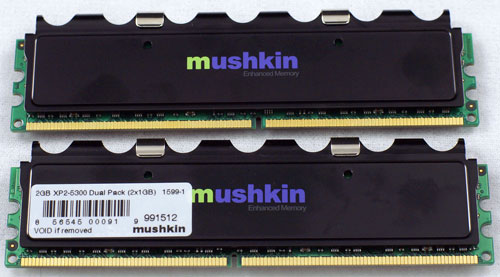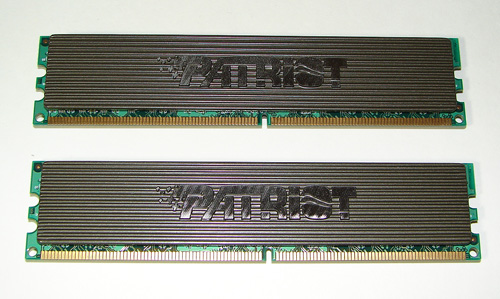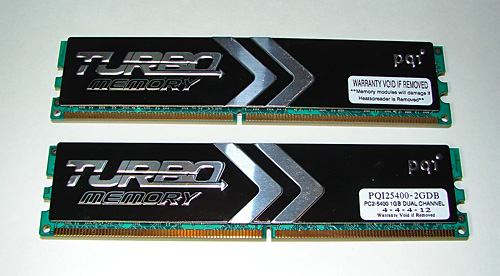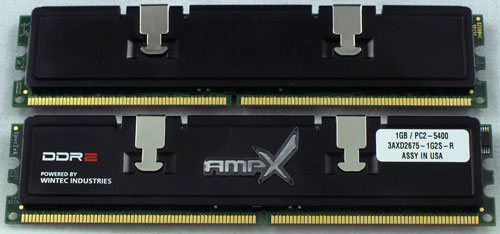Conroe Buying Guide: Feeding the Monster
by Gary Key & Wesley Fink on July 19, 2006 6:20 AM EST- Posted in
- Motherboards
Mushkin eXtreme DDR2-667

The Mushkin DDR2-667 memory arrived with the highest price in our value roundup, an excellent heat spreader design, but performed below average at the DDR2-667 and DDR2-800 settings. We raised the voltages but did not have any success in improving the timings at these settings. However, the Mushkin ran at stock voltages for the low latency DDR2-400 and DDR2-533 settings although the 3-3-3-8 timings at DDR2-533 could not be improved with additional voltage to match the 3-2-2-7 timings of other modules. Also, this is the only memory in our group that would not run 4-3-3 settings at DDR2-800. Although the performance difference is minimal, the cost of this kit indicates the memory should perform better.
Patriot DDR2-667

Patriot Memory provided their Extreme Performance series memory modules that provided above average performance at voltage settings that were more than acceptable for 24/7 operation. The memory comes with stylish heat spreaders and was able to easily clock up to DDR2-900 at extended voltages and 5-5-5-15 timings, though we recommend the lower latencies at DDR2-800.
PQI Turbo DDR2-667

The bargain of the bunch has to be the PQI Turbo kit that is currently selling for around $117 with rebate. While the timing performance of the memory was excellent we had to run at voltages higher than the group's average to meet these settings. The base voltage for this particular model is 2.0V, something to be aware of based upon our results with the other memory modules.
Wintec AMPX DDR2-667

The Wintec AMPX DDR2 Extreme series of memory was the pleasant surprise of the group as it generated excellent timings at low voltages at the lower memory speeds. It performed average at DDR2-800, although the results are more than acceptable.
Comparing Value Memory
All of the memory in the value section was able to run on average 4-3-3-9 settings at DDR2-800 except for the Mushkin modules that were limited to 4-4-4-12 but at a low 2.0V setting. The performance delta is extremely minor and the lower voltages are welcomed, but the Mushkin memory is the most expensive in our group so we naturally expect more from it.
The ability of all our value memory to run at very low latencies at DDR2-667 and 4-3-3-9 latencies at DDR2-800 is just incredible given the average price of $148 for a 2GB kit. Not even a year ago this type of performance in the DDR2 world would have placed this "value" memory at the top of performance charts. We found the Elpida memory to offer higher overclocks at lower memory voltages overall than the Infineon based modules, making it the current leader in value performance memory in our opinion.
The two modules that stood out were the A-Data Vitesta DDR2-533 and Wintec AMPX DDR2-667. During testing, both offered a unique combination of price, performance, and stability. All of the memory reviewed is more than acceptable for a Conroe system and the performance differences are so minor that we suggest choosing a supplier based upon prior experience, warranty, or price in this case. We will be looking at additional value memory modules from other suppliers shortly along with providing performance test results with our new Core 2 Duo Memory test platform.

The Mushkin DDR2-667 memory arrived with the highest price in our value roundup, an excellent heat spreader design, but performed below average at the DDR2-667 and DDR2-800 settings. We raised the voltages but did not have any success in improving the timings at these settings. However, the Mushkin ran at stock voltages for the low latency DDR2-400 and DDR2-533 settings although the 3-3-3-8 timings at DDR2-533 could not be improved with additional voltage to match the 3-2-2-7 timings of other modules. Also, this is the only memory in our group that would not run 4-3-3 settings at DDR2-800. Although the performance difference is minimal, the cost of this kit indicates the memory should perform better.
| Mushkin - DDR2-667 - 2x1GB Model # 991512 |
||
| CPU Ratio | Memory Speed |
Best Memory Timings (Voltage) |
| (4:3) | 400 DDR2 | 3-2-2-5 1.8V |
| (1:1) | 533 DDR2 | 3-3-3-8 1.8V |
| (4:5) | 667 DDR2 | 3-3-3-10 2.1V |
| (2:3) | 800 DDR2 | 4-4-4-12 2.0V |
Patriot DDR2-667

Patriot Memory provided their Extreme Performance series memory modules that provided above average performance at voltage settings that were more than acceptable for 24/7 operation. The memory comes with stylish heat spreaders and was able to easily clock up to DDR2-900 at extended voltages and 5-5-5-15 timings, though we recommend the lower latencies at DDR2-800.
| Patriot - DDR2-667 - 2x1GB Model # PDC22G5300LLK |
||
| CPU Ratio | Memory Speed |
Best Memory Timings (Voltage) |
| (4:3) | 400 DDR2 | 3-2-2-5 1.9V |
| (1:1) | 533 DDR2 | 3-2-3-7 1.9V |
| (4:5) | 667 DDR2 | 3-3-3-8 2.1V |
| (2:3) | 800 DDR2 | 4-3-3-8 2.1V |
PQI Turbo DDR2-667

The bargain of the bunch has to be the PQI Turbo kit that is currently selling for around $117 with rebate. While the timing performance of the memory was excellent we had to run at voltages higher than the group's average to meet these settings. The base voltage for this particular model is 2.0V, something to be aware of based upon our results with the other memory modules.
| PQI - DDR2-667 - 2x1GB Model # PQI25400-2GDB |
||
| CPU Ratio | Memory Speed |
Best Memory Timings (Voltage) |
| (4:3) | 400 DDR2 | 3-2-2-5 2.0V |
| (1:1) | 533 DDR2 | 3-2-2-7 2.0V |
| (4:5) | 667 DDR2 | 3-2-3-9 2.2V |
| (2:3) | 800 DDR2 | 4-3-3-9 2.2V |
Wintec AMPX DDR2-667

The Wintec AMPX DDR2 Extreme series of memory was the pleasant surprise of the group as it generated excellent timings at low voltages at the lower memory speeds. It performed average at DDR2-800, although the results are more than acceptable.
| Wintec AMPX - DDR2-667 - 2x1GB Model # 3AXD2675-1G2S-R |
||
| CPU Ratio | Memory Speed |
Best Memory Timings (Voltage) |
| (4:3) | 400 DDR2 | 3-2-2-5 1.8V |
| (1:1) | 533 DDR2 | 3-2-2-7 1.9V |
| (4:5) | 667 DDR2 | 3-3-3-8 2.15V |
| (2:3) | 800 DDR2 | 4-3-3-9 2.2V |
Comparing Value Memory
All of the memory in the value section was able to run on average 4-3-3-9 settings at DDR2-800 except for the Mushkin modules that were limited to 4-4-4-12 but at a low 2.0V setting. The performance delta is extremely minor and the lower voltages are welcomed, but the Mushkin memory is the most expensive in our group so we naturally expect more from it.
The ability of all our value memory to run at very low latencies at DDR2-667 and 4-3-3-9 latencies at DDR2-800 is just incredible given the average price of $148 for a 2GB kit. Not even a year ago this type of performance in the DDR2 world would have placed this "value" memory at the top of performance charts. We found the Elpida memory to offer higher overclocks at lower memory voltages overall than the Infineon based modules, making it the current leader in value performance memory in our opinion.
The two modules that stood out were the A-Data Vitesta DDR2-533 and Wintec AMPX DDR2-667. During testing, both offered a unique combination of price, performance, and stability. All of the memory reviewed is more than acceptable for a Conroe system and the performance differences are so minor that we suggest choosing a supplier based upon prior experience, warranty, or price in this case. We will be looking at additional value memory modules from other suppliers shortly along with providing performance test results with our new Core 2 Duo Memory test platform.










123 Comments
View All Comments
Beaner - Wednesday, July 19, 2006 - link
Very well-written article guys!Thanks for taking the time to enlighten us all.
Just wanted to point out that the Mushkin Redline sticks can be had right now for $355 AR. At that price, I may just have to grab 'em myself!
ChronoReverse - Wednesday, July 19, 2006 - link
It was pretty much shown that the effect of using memory dividers for Athlon64's was rather minimal while most dividers were more adverse for Netburst.How large of an effect does using memory dividers have on the Conroe?
Wesley Fink - Wednesday, July 19, 2006 - link
The effect of memory dividers is much smaller on Conroe than we saw on Netburst. In fact memory dividers on Conroe behave more like AM2 - probably the result of the "apparent" reduction in latency with the intelligent look-ahead in memory. Core 2 Duo is not Hyper-Transport, so 1:1 (533) tis still theoretically the highest performing setting, but we were hard pressed to find any measurable advantage of 1:1 in most situations.We had tested a number of high-performance dimms on Conroe before we wrote the Buyers Guide, but there just wasn't the time - or room - to include full memory performance data in the Guide. We do have memory reviews in process that will provide specifics to your questions.
We can summarize what we have learned about memory on Conroe so far. DDR2-667 is quite a bit higher in real perfomance than DDR2-400 or DDR2-533 (1:1). We would consider DDR2 to be the minimum memory that should be used with Conroe. Going up from DDR2-667 we found the following - from fastest to DDR2-667. DDR2-1067 4-4-4 is a bit faster than DDR2-800 3-3-3 is a bit faster than DDR2-667 3-2-3. Timings are very important above DDR2-667 and you can give up any performance advantage with slower timings. DDR2-667 is a good match to COnroe bandwidth, and is better perfoming than 533 or 400 by a wider marging than you find above DDR2-667. It also appears Conroe responds better (performs better with increases) to DDR2 bandwidth increases than either Netburst or AM2.
Wesley Fink - Wednesday, July 19, 2006 - link
We would consider DDR2-667 the minimum memory to use with Conroe, and faster timings do generally improve performance.Sunrise089 - Wednesday, July 19, 2006 - link
I would like to know this as well.txt2000 - Wednesday, July 19, 2006 - link
Just wondering, if your going to spend ~$400 on memory if you would be better off with 4GB value DDR or 2GB high performance.Patsoe - Wednesday, July 19, 2006 - link
I suppose that completely depends on your usage pattern. Almost all of my activities fit within 512MB, and probably anything I do fits within 768MB. So getting faster RAM would do more for me than more of it.If you could fill 3GB, then a setup with 2GB will see a lot hard-disk swapping... even a very slow 4GB of RAM will do better in that case.
Andy4504 - Wednesday, July 19, 2006 - link
Anything over 1GB results in the OS addressing your memory differently. Never did the reasearch on how that different addressing affected system performance however.supremelaw - Wednesday, July 19, 2006 - link
http://www.anandtech.com/mb/showdoc.aspx?i=2797&am...">http://www.anandtech.com/mb/showdoc.aspx?i=2797&am...Timing and content were perfect for this article.
And, your earlier article on the nVidia 590 chipset
for Intel also dovetails perfectly: nice photos too.
August+ should be VERY interesting.
Many thanks!
Sincerely yours,
/s/ Paul Andrew Mitchell
Webmaster, Supreme Law Library
http://www.supremelaw.org/">http://www.supremelaw.org/
mobutu - Wednesday, July 19, 2006 - link
"The board was very stable with our X6800 and X6600 Core 2 Duo processors ..."It should have been E6700 (or maybe E6700)